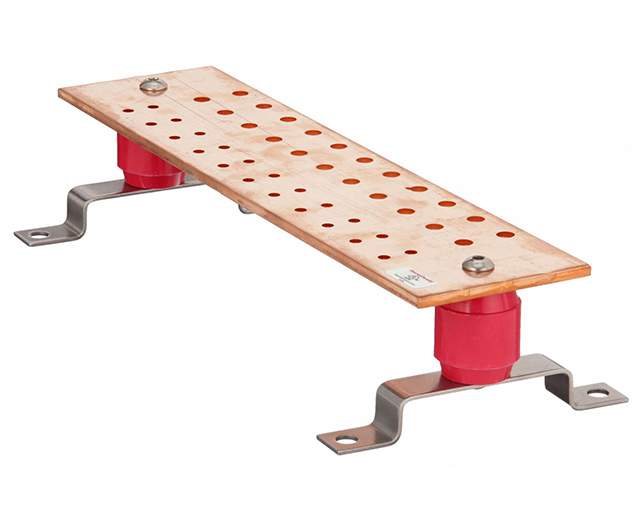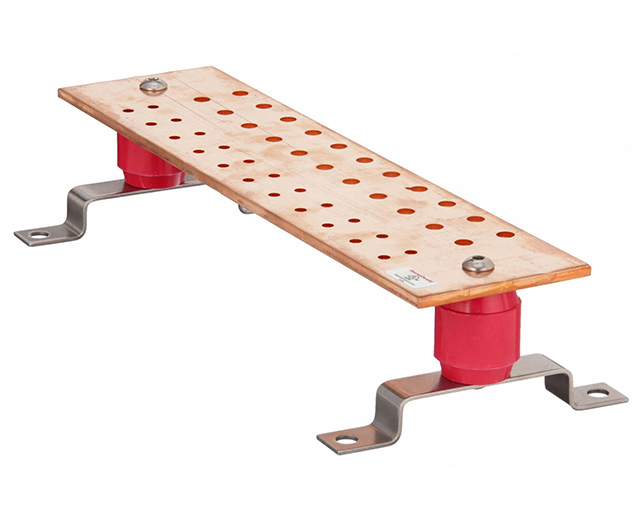

An isolated bus bar—also known as an isolated ground bus bar or isolated phase busbar—is a specialized electrical conductor designed to distribute power safely while providing complete insulation between live phases and ground potential.
Unlike a traditional bus bar or ground bus bar, the isolated bus bar integrates high-grade insulation materials to prevent short circuits, reduce electrical noise, and improve overall system reliability. It is widely used in switchgear, EV battery systems, renewable energy converters, data centers, and industrial automation equipment.

The production of an isolated bus bar follows a precise and controlled multi-step process to ensure excellent electrical and mechanical performance:
Material Selection & Cutting
High-conductivity copper (Cu) or aluminum (Al) plates are selected and cut according to the system’s current capacity and layout.
Surface Treatment
The conductor undergoes electro-tinning, nickel plating, or silver plating to enhance corrosion resistance and reduce contact resistance.
Insulation Layer Coating
The metal conductor is fully encapsulated with epoxy resin, PET film, or heat-shrink insulation to achieve dielectric isolation between phases.
Curing & Quality Inspection
The insulated assembly is cured at controlled temperature and tested for insulation resistance, dielectric strength, and mechanical rigidity.
Final Assembly
Mounting brackets, end connectors, and insulation spacers are added to ensure easy installation and long-term durability.
This process allows the isolated phase busbar to safely transmit large current loads while maintaining compact design and minimal electromagnetic interference.
Compared with conventional bus bar or ground bus bar systems, our isolated bus bars offer the following superior advantages:
| Feature | Description | Benefit |
|---|---|---|
| High Insulation Strength | Multi-layer dielectric coating up to 5kV | Prevents phase-to-phase short circuits and electric shock |
| Compact Modular Design | Space-saving layout with integrated insulation | Ideal for high-density electrical cabinets |
| Excellent Heat Dissipation | Uniform copper structure with thermal conduction path | Ensures stable performance under high current |
| Low Inductance & Resistance | Laminated and optimized conductor geometry | Improves energy efficiency and reduces power loss |
| Corrosion-Resistant Surface | Tin/Nickel/Silver plating | Long service life even in humid or corrosive environments |
| Customizable Options | Flexible shapes, mounting holes, and terminal types | Meets various installation standards (IEC, UL, CE) |
Our isolated bus bars are made using the finest materials for maximum performance and reliability:
| Material Type | Description | Typical Application |
|---|---|---|
| Copper (C1100/C1020) | High conductivity (≥99.9%) | Power distribution, switchgear |
| Aluminum (6061/6063) | Lightweight and economical | EV battery modules, inverters |
| Insulation Layer | Epoxy resin, PET, PVC, or heat-shrink | Provides dielectric isolation |
| Surface Finish | Tin/Nickel/Silver plated | Anti-oxidation, enhanced conductivity |
| Parameter | Range / Option | Description |
|---|---|---|
| Thickness | 2 mm – 12 mm | Customized per current rating |
| Width | 10 mm – 100 mm | Available for single or multi-phase design |
| Current Capacity | 100 A – 3000 A | Depending on conductor cross-section |
| Insulation Resistance | ≥100 MΩ @ 1000V DC | High dielectric performance |
| Surface Treatment | Tin, Nickel, or Silver Plated | Improved corrosion resistance |
| Operating Temperature | –40°C ~ +125°C | Suitable for harsh environments |
| Rated Voltage | Up to 1500V DC | For medium and high-voltage systems |
The isolated ground bus bar is versatile and widely used across multiple industries:
Electric Vehicles (EVs) – Battery connection systems and power distribution.
Power Distribution Units (PDUs) – Data centers, telecommunication cabinets.
Renewable Energy Systems – Solar inverters, wind turbine converters.
Switchgear and Control Panels – Medium-voltage or high-voltage power cabinets.
Industrial Automation – Robots, drives, and servo systems.
Railway and Marine Equipment – Compact electrical systems requiring high reliability.
To ensure safe operation and long service life of your isolated bus bar system:
Ensure proper torque on all fasteners and connectors.
Keep insulation layers clean and free from dust or oil.
Avoid bending the bar beyond its specified radius.
Regularly inspect for corrosion or surface damage.
Maintain adequate ventilation around high-current paths.
Proper installation and periodic maintenance significantly improve performance and extend product lifespan.
As a professional bus bar manufacturer and supplier, we stand out from other isolated bus bar suppliers in the following ways:
Comprehensive Customization – We design and produce according to your drawings, voltage, and current requirements.
Advanced Production Equipment – CNC precision punching, automatic insulation coating, and 100% inspection.
Certified Quality System – ISO9001, RoHS, CE-compliant production process.
High Conductivity, Low Power Loss – Use of premium copper/aluminum ensures stable electrical performance.
Global Delivery & Technical Support – Fast response for OEM/ODM projects with strong logistics network.
When you partner with us, you get engineered reliability, precision manufacturing, and competitive pricing.
Q1: What is the difference between an isolated bus bar and a ground bus bar?
A: A ground bus bar connects directly to the grounding system, while an isolated bus bar or isolated ground bus is insulated from the chassis and other conductive parts to avoid ground loops and ensure electrical isolation.
Q2: Can the isolated bus bar handle high-current applications?
A: Yes. Depending on design, our isolated bus bars support continuous currents from 100A up to 3000A.
Q3: Can you customize the dimensions and insulation material?
A: Absolutely. We offer full customization for thickness, width, mounting holes, insulation color, and material type.
Q4: What surface treatment options are available?
A: Tin, nickel, and silver plating are standard. Custom finishes are available on request.
Q5: How do I order or get a quotation?
A: Please provide your drawing, current rating, and quantity. Our engineering team will evaluate and provide a quotation within 24 hours.